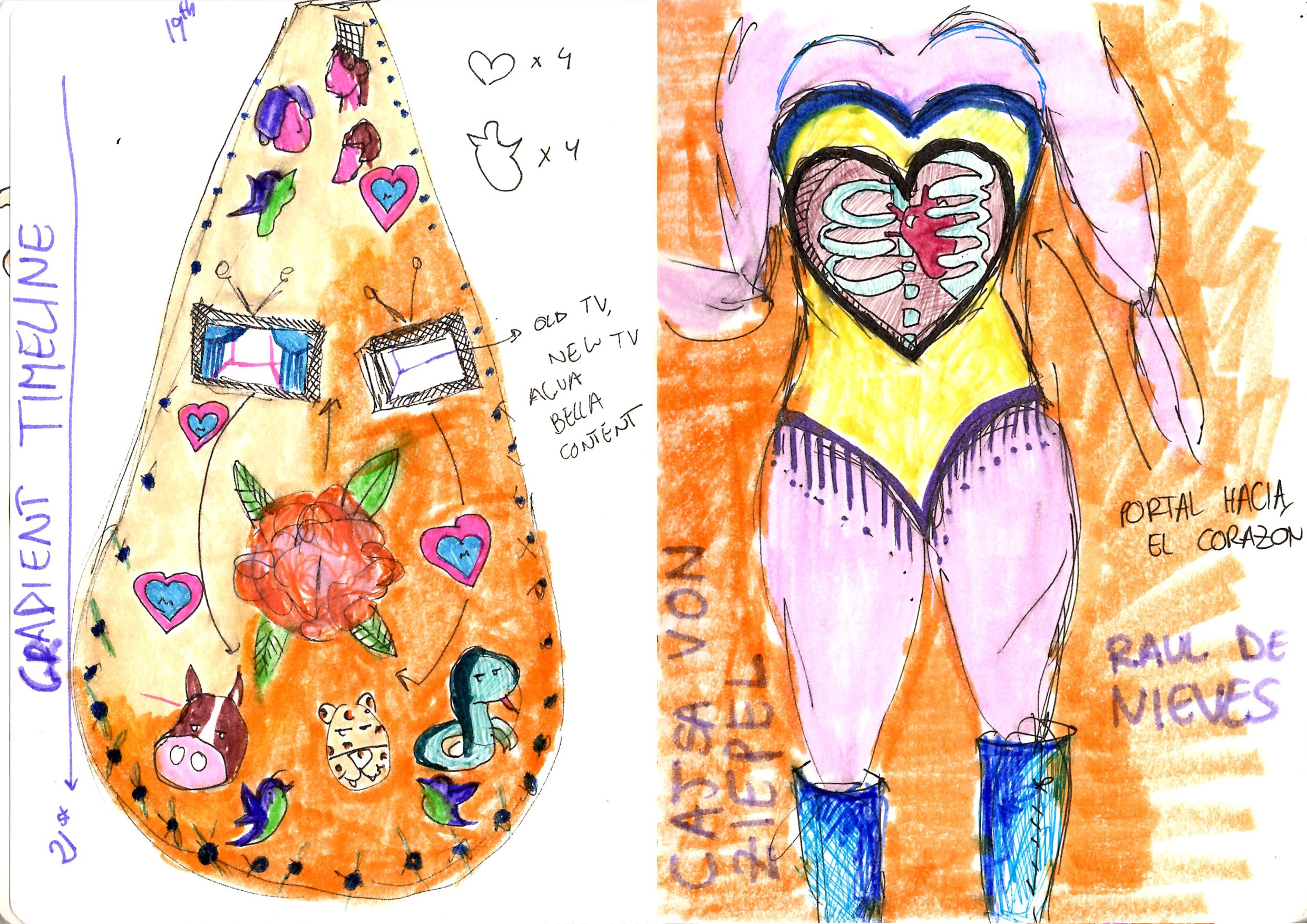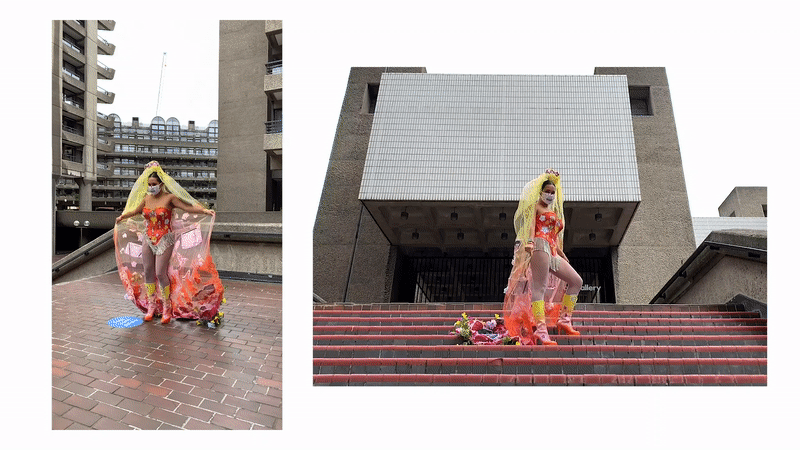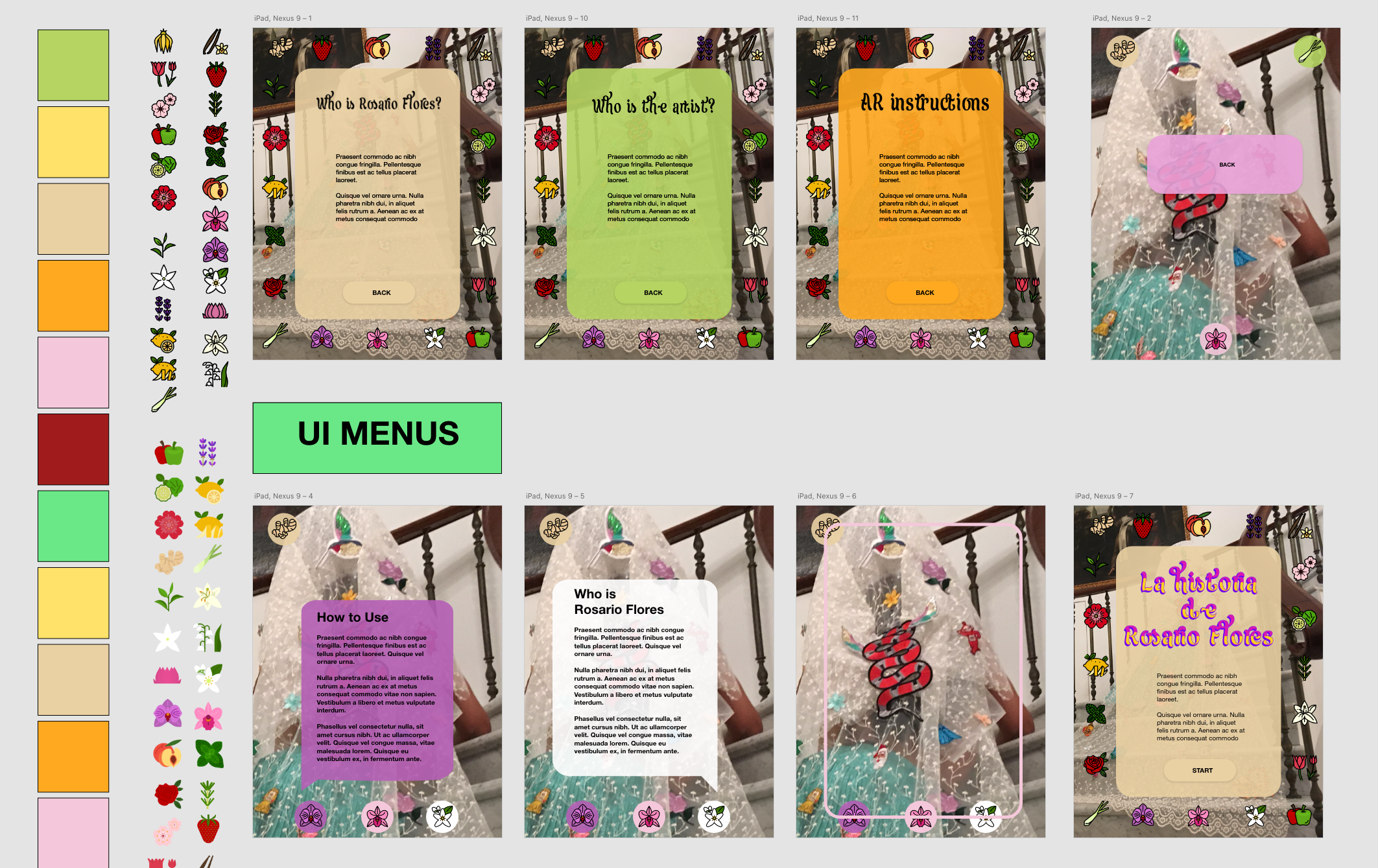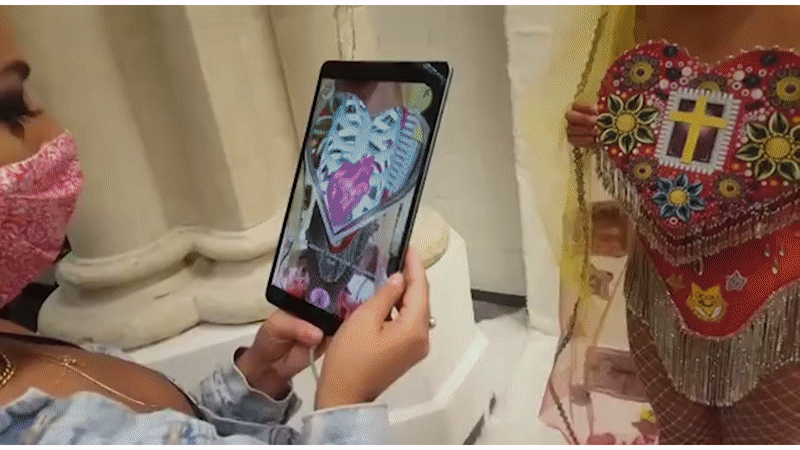La Historia de Rosario Flores
An interactive installation that uses Augmented Reality as a medium to scan and excavate different stories about machismo culture in Lima Peru through the garments and veil of a Transhumanist Virgin.
produced by: Alesandra Miro Quesada
In collaboration with Edward Mendoza, Desire Frank, and David C.
Introduction
Rosario Flores is a Posthuman Virgin who has encoded within her the relics of a culture once intoxicated by biological sin. She was born on the 8th of October 2202, in Lima Peru, and is one of many Posthuman Virgins roaming the bridges between flesh and code.
Like most virgins, she is programmed with a purpose: she is to carry debris of a culture that once believed in God, she is an archeological site for machismo in Peruvian culture. Within her vail, she carries stories of empowerment as well as suffering and is set to roam the confinements of cyberspace for any cyber-archaeologist to discover.
As a Posthumanist, she is resistant to disease and impervious to aging; she has the ability to exercise control over her own desires, moods, and mental states. She has experiences and concerns that her ancestors could not have fathom, thoughts that could not fit into the three-pound lumps of neural tissue that the last biological humans used for thinking.
Concept
I have focused most part of my MA on researching the use of interactive technology to tackle the subject of violence against women in my native country of Lima, Peru. I believe that technology has the ability to transmit great empathy and is powerful enough to speak truths and create change. This piece was born out of watching cable TV as a child. I particularly remember two things: news about women being murdered by their ex-partners and live talk shows where women would dance in small outfits to cumbia. At the time I was blissfully unaware of what was going on, it was just news and entertainment.
Flash forward ten years later I find myself revisiting these clips with a completely different perspective, the perspective of Rosario Flores. I created her with an aim: archivar para nunca regresar pero siempre acordar (archive so we never return but we always remember). There is a very tragic history when it comes to contemporary women's rights in Peru, as in most countries in Latin America as in most countries of the world. Some of these stories have now been changed, but in Peru, the gears are turning slowly. They are, however, turning.
This piece is my attempt to help with the effort of turning those gears of change; by creating an interactive installation that allowed the audience to step inside the future and look back on what was once a world of injustice against women. The installation, therefore, had to be a female, she had to be a conglomeration of all the past moments good and bad that changed feminist history forever, and that lead to where we are now as a country. She not only had to hold people accountable for their acts but also educate the public on all the fantastic work that has been done by countless unsung heroines, activists, journalists, poets, and educators staring all the way back to the 15th century in Peru.
I created Rosario Flores as a Posthuman Virgin - a hybrid mestiza that carried in her garments a gradient from feminism at the top of her vail to machismo at the bottom, with all the muddled humans and purgatory in the middle. I took great inspiration in the Italian Renaissance and later on the Peruvian take on Italian renaissance, La Escuela Cuzqueña (The Cuzco School). Particularly their depiction of virgins as well as their famous pictorial compositions of having the good guys at the top, in the Heaves, and the bad guys, at the bottom in Hell. It was also very important for me to capture the essence of contemporary Peruvian popular culture, color pallet, and aesthetics. In the following section are the main inspirations for my work.
Background research
There are may powerful artists and academics out there that have inspired me to come up with different concepts throughout the course of this degree. For this particular project, I took inspiration from an array of artists, dancers, writers, and poets, however, my main artistical and visual inspiration came from:
Most works of Raul De Nieves and Cajsa von Zeipel, particularly the piece they did for the Company Gallery booth at Art Basel:
https://companygallery.us/fairs/art-basel-miami-beach-2019/
https://www.bulgari.com/en-int/stories/raul-de-nieves-at-art-basel.html
https://www.youtube.com/watch?v=Lo36yJF0Z0k
https://www.andrehn-schiptjenko.com/cajsa-von-zeipel/
Long time inspiration Jordan Wolfson:
https://www.youtube.com/watch?v=mVTDypgmFCM
https://www.youtube.com/watch?v=HVT1RbVss6M
Muralist and Caligraphy artist Elliot Tupac:
https://www.instagram.com/elliottupac/?hl=en
La Escuela Cuzqueña (Cuzco School), Roman Catholic artistic movement based in Lima, Peru during the Colonial period from the 16th to 18th Centuries. Particularly artist Diego Quispe Tito:
https://www.brooklynmuseum.org/opencollection/objects/671
https://collections.lacma.org/node/220969
The mesmerizing, colorful, and unique festival of Paucartambo, and all its generations of artisans and artists that put it together year after year:
https://www.cusconative.com/paucartambo-festival/
https://www.youtube.com/watch?v=QkDKQGZpkuU
https://issuu.com/crespial/docs/festividad-de-la-mamacha-carmen-de-
Agua Bella cumbia group, their lyrics, music, and costumes:
https://www.youtube.com/watch?v=pPz8TuteO2I
https://www.youtube.com/watch?v=v2XITac6FKk
https://www.youtube.com/watch?v=W65-LcFKP_g
All of the above artists have been a part of my journey to create the character of Rosario Flores. I constantly would go back to their work, listen to their songs, watch videos, or read about their lives every time I was stuck. I would say that 60% of this project was spent on researching. It was very important for me to get my facts right in order to tell a truthful and accurate story. I was lucky enough to gain access to pdf books and download archive footage from various online resources of Peruvian universities such as from the Universidad Catolica del Peru (Catholic Peruvian University) who have a fantastic online library and archive.
The more that I read into the history of Peruvian feminism and its protagonists the more that I knew this piece had to live up to the people I was representing. I conducted I am still conducting various interviews with an array of different people not only to pitch my idea to as many people as possible but also to gather and learn from their feedback:
Aranzazu Jorquiera - Consultant and Comunity Manager at Genderlab Peru
Daniela Meneses - Journalist specializing in gender issues in Peru, MSc @LSE Gender Studies
Desire Frank - Artist and Illustrator focusing on gender equality
Violeta Quispe De Sarhua - Artist and activist for violence against women in Cuzco, Peru
Nancy La Garotinha - Former member of Agua Bella group
Technical
The technology that I used for this project was Augmented Reality. I am absolutely mesmerized by this medium and feel like artists are not using it enough and that I have been exploring for the past years in my practice. I think that this medium is extraordinary because it can be used to reveal things hidden in the physical world. It has the potential to bring in magic realism into the ordinary by augmenting your surroundings and seducing you to discover. Nevertheless, the technology was just one aspect of the technicalities of my piece. I also had to design the physically augmentable garment as well as the illustrated image targets and the AR app itself... yikes!
I have always felt good about collaborating and it was clear to me that in order for me to achieve Rosario Flores I had to reach out to super talented fashion designer and fellow Peruvian Central Saint Martins buddy, Edward Mendoza (https://www.instagram.com/warpigwonder/), together we created the cumbia orange corset as well as the design and making of the vail. As for the illustration Image targets, I got in contact with fantastic illustrator and childhood friend Desire Frank (https://www.instagram.com/dizzyfrankk/). She has taken part in many feminist and gender equality campaigns on and off social media. I have been a big fan of her style so I immediately knew she would get my work and also empathize with the subjects that I wanted to portray.
For the development of the AR app itself, I used Unity as my main engine and Vuforia to create AR Image Targets. This was my second time working with Vuforia instead of ARKit/ARCore, the main reason for choosing this is that you can build for android and iOS much quicker and don't have to download heaps of different packages for each individual platform. Vuforia also has the upper hand on quick prototyping as it allows for the use of the webcam to test as you work instead of having to build to a device every time you want to test AR.
I encountered (what now seems to be) countless challenges when developing the AR app. First and foremost my piece was in Spanish and I was presenting it to a primordially English-speaking audience, this meant that right off the bat I had to come up with a subtitling system. Luckily I had some experience working with strings and formatting them from my previous Creative Coding 2 Congressional Scandal Generator work, what I didn't have much experience with was C# language. Even though I had used AR and Unity in the past, this time my aim was to create not only the AR but also the UI and UX experiences. The app itself needed to be coherent and user friendly enough that the viewer would understand what to do. That included menus, character introductions, app instructions, and of course the subtitling that I mentioned earlier. All fo this was a very big learning curve for me, especially the UI part which I got very muddled in. Nevertheless, C# in Unity has so much documentation and online video resources that I almost always found a solution to my problem.
Source Code:
https://github.com/badgrandpa/LaHistoriaDeRosarioFlores
Future development
Rosario Flores is just the start of a journey. She is the first prototype of a much more in-depth investigation. There is so much more to be analyzed and spoken about in this vail and because of time I did not include. One thing in particular that I want to include in future development is the voices of all the contemporary feminists that are fighting for equality every day through popular media, theatre, film, journalism, and literature. I feel that with their voices the vail will really have a more contemporary and hopeful feeling about it.
Like I mentioned in the introduction Rosario Flores is one of many Posthuman Virgins. I have plans to create more and have them roaming around cyberspace as well. These virgins are going to depict themes like the illegality of abortion in Peru, the treatment towards Peruvian Transgender citizens, and the struggles of the Amazonian and Andean indigenous women. I will not stop creating Posthuman Virgins until all of these themes are met and I feel like they are ready to be archived to roam the abstract world of the digital forever. We might forget, but they never will.
I want to focus my time and efforts after this degree in finding an art residency. I am not particular of where but I want it to be a place where I can fully explore my feminist techno scientist approach and learn more about other female tech artists out there.
Self-evaluation
What worked?
I successfully managed to create an AR app that allowed the public to scan Rosario Flores augmented garment and learn about violence against women in Peru. Overall I am overwhelmed but thrilled with the outcome of this project and how it all worked out. I think the themes where clear and the tech worked nicely, I was also very happy with the public reaction and the feedback that I got from fellow artists, friends, and family.
What didn't?
Even though a lot of things went well, there area few that didn't, in particular: time management. I found out halfway through the project that I had too much work and not enough time. I had spent a lot of the initial months reading, researching, and conducting interviews and found out too late that I had left the production of the app itself way to the last minute.
I did not realize the immense physical, technological, and emotional challenges that this work would uncover. Not only from the difficult theme of violence against women but also to the production of such garments and achieving the details I was after. This project definitely broke me down more than once but I have learned so much
What would you have done differently?
The most important thing that I have learned from this project is if you want to accomplish professional-looking work and collaborate with other artists you must think of yourself as a producer and not just and artist. Also, as I mentioned earlier, I would have kept a much closer eye on the time and my emails with all of the
Your overall impression of your project.
I am still processing my work. I feel this has been one of the most emotional and out of my comfort zone project I have ever done. Even though it tackled subjects that I have investigated in the past, it was the sheer act of standing in costume performing this character that really changed the way that I related to this character. This is my first ever performance and even though I may appear confident in the costume, underneath I was incredibly scared and overwhelmed by the piece I myself had created.
Did you achieve what you set out to achieve? Why? Why not? Acknowledge your mistakes for better grades...
I am happy to say that one way or another I achieved what I set out to achieve. I think it took a lot of passion and attention to detail that after many mistakes I managed to accomplish. It took a lot of organization and communication between myself and fellow collaborators to really push ourselves to deliver. For example below is a screengrab of the list of all of the assets that were going to have some type of AR in them. Out of the list, I could not complete all of them but it was nevertheless indispensable for the organization fo the team and myself.
One thing that I didn't manage to achieve was to help the exhibition organization team as much as I would have liked. At the start I was involved with the curatorial and the tech-digital team, however, the closer we got tot he deadline the more work just piled up. In the end, I had to drop out of my duties if I was going to get this work done on time. Again, another reason why time management is so important.
References & Bibliography
Edward Mendoza's feature on Latex Magazine
http://latexmagazine.com/conoce-a-edward-mendoza-el-disenador-peruano-detras-de-warpig-wonder/
Virtual Library Migues de Servantes - Sentimentalism, gender and republican virtue on Clorinda Matto de Turner
http://www.cervantesvirtual.com/obra-visor/sentimentalismo-genero-y-virtud-republicana-en-clorinda-matto-de-turner/html/99938263-f5e6-40f4-bfb8-
35ff48284692_5.html
Active social media feminist and poet enthusiast Katya Adaui
https://www.facebook.com/katyaadaui
Congresswoman Maritza Garcia: "women give the opportunity to the male to commit femicides"
https://peru21.pe/politica/maritza-garcia-mujer-da-oportunidad-varon-cometa-feminicidio-video-379738-noticia/
Psychologist Ivan Molina expresses himself on being quoted by Maritza Garcia
https://eltiempo.pe/asi-se-expreso-psicologo-ivan-molina-salas-citado-maritza-garcia/
Documentary It Happened in Peru, an episode on Feminism
https://www.youtube.com/watch?v=0I3iCUieYUQ
Nineteenth-century Liberal Feminism in Peru by Monica Cardenas Moreno
https://journals.openedition.org/amerika/8302
Agua Bella performing Lucerito - video from Serkool5 archive
https://www.youtube.com/watch?v=FiJnZKVrC5E
Rossi Bradotti "Posthuman Talk" at Harvard GSD
https://www.youtube.com/watch?v=0CewnVzOg5w
Francesca Denegri reproduces the letter from Juan de Arona in her book The fan and the ashtray
http://docplayer.es/34444743-Francesca-denegri-reproduce-la-carta-de-juan-de-arona-en-su-totalidad-en-el-abanico-y-la-cigarrera.html
Essay: An intellectual look at Tecnocumbia, getting closer to a cultural manifestation that causes polemic
http://www.uasb.edu.ec/UserFiles/File/una%20mirada%20intercultural-eduardo%20puente.pdf
Essay: The ludic aesthetics in tecnocumbia by David Troya Molina for the Andean University Simon Bolivar, Ecuador.
https://core.ac.uk/download/pdf/159775324.pdf
Essay: Erotism in tecnocumbia through hypermedia by Nataly Moreano Pozo, University of Palermo Argentina.
http://fido.palermo.edu/servicios_dyc/proyectograduacion/archivos/4881.pdf
Danilo Martuccelli, Lima y her sands. Social Power and cultural hierarchy
https://journals.openedition.org/nuevomundo/69400
‘Con mis hijos no te metas’ is a campaign of international misinformation, points out Indira Huilca
https://www.youtube.com/watch?v=0AayifAl5bg
Gender Ideology: polemic implementation in national curriculum keeps on creating a polemic
https://www.youtube.com/watch?v=txy2l-0rfdw
Un violador en tu camino (A rapist in your path) performance in Kenedy Park, Lima Peru
https://www.youtube.com/watch?v=myuwlM-SlRo
Archive website where episodes of Ambulantes de la Risa can be found
http://cyberspaceandtime.com/uz9KA49Zh6o.video+related
Ambulante de la Risa - Episode of their segment The Sexist
https://www.youtube.com/watch?v=l1YSdH58eNc
Ambulante de la Risa - Episode of their segment The Sexist
https://www.youtube.com/watch?v=Bv25zTcgeHc
Cardenal Cipriani: "Women put themselves up for display"
https://www.youtube.com/watch?v=xwlA60FVH54&t=670s
Mari Jesus Alvarado Rivera - Biography and Manifesto
http://www.mimp.gob.pe/files/direcciones/dgignd/campanias/MJAlvarado_Historia_Manifiesto.pdf
Feminism Conference read in the Geographical Society by Maria Jesus Alvarado
https://www.scribd.com/doc/70711637/El-Feminismo-Maria-Jesus-Alvarado
An outline of Peruvian feminism: the multiple challenges, by Violeta Barrietos Silva and Fanni Muñoz Cabrejo
https://www.scielo.br/pdf/ref/v22n2/a15v22n2.pdf
Norma Barúa Lanchippa en Universidad de Piura, Peru.
http://lasoga.org/peru-mercedes-cabello/
Blogpost on Mercedes Cabello Llosa de Carbonera Peruvian writer initiator of the Peruvian realist novel.
http://marivi-hypatia.blogspot.com/2016/10/mercedes-cabello-llosa-de-carbonera.html
Hysteria and madness as part of the philosophy of the Comtean brain in the work of Mercedes Cabello de Carbonera by Monica Cardenas Moreno
https://www.academia.edu/4319155/Histeria_y_locura_como_parte_de_la_filosof%C3%ADa_del_cerebro_comteana_en_la_obra_de_Mercedes_Cabello_de_Carbonera
Call her Andrea: The Quechua patriot shot in 1822 for protecting the country from the monarchy
https://perubicentenario.pe/destacados/llamala-andrea-la-patriota-quechua-fusilada-en-1822-por-proteger-al-pais-de-la-monarquia/
Maricarmen Marin 20 years old - Crazy sweetheart / Impossible to forget you
https://www.youtube.com/watch?v=xDhcR12jRlQ
Comedian Marco Castañeda Quiñones "Tornillo" († 2002)
https://www.facebook.com/watch/?v=405979074227
Happy Scribe Website
https://www.happyscribe.com/user
Sandra Rodriguez anthropologist from Cajamarca currently studying at Cambridge
https://twitter.com/LaSandunga7
Sandra Rodriguez blogpost, short stories and poetry
https://tierraadentro.home.blog/161-2/
SELECTED ESSAYS (1874-1877) MERCEDES CABELLO DE CARBONERA Selection of Texts and Foreword by Nelly Goswitz
https://www.researchgate.net/publication/329706318_ENSAYOS_SELECTOS_1874-1877_MERCEDES_CABELLO_DE_CARBONERA_Seleccion_de_Textos_y_Prologo_a_cargo_de_Nelly_Goswitz
"Don't interrupt me": women and the Latin American essay by Mary Louise Pratt and Gabriela Cano
https://www.jstor.org/stable/42624563
The indigenous feminism of the colonial period by Vicente Alban / Museo de America
https://theconversation.com/el-feminismo-indigena-de-la-epoca-colonial-112566
Clorinda Matto de Turner: Hima-Sumac OR The Secret of the Incas, a historical drama in three acts and in prose.
https://biblioteca.org.ar/libros/142469.pdf
Archive on Clorinda Matto de Turner 1852 - 1909
https://openlibrary.org/authors/OL399699A/Clorinda_Matto_de_Turner
Four conferences on Latin America by Clorinda Matto de Turner
https://archive.org/stream/cuatroconferenci00matt?ref=ol#page/34/mode/2up
A fundamental conversation with Judith Butler who will share visions on "Pandemics, Democracies and Feminisms" with the journalist and vice-rector Faride Zeran and the president of the FECH - Federation of Students of the University of Chile Emilia Schneider.
https://www.youtube.com/watch?v=7vCWgcp0r8o&fbclid=IwAR14sxDRPVRVho9ZaGF6VUaJHz-SVptVhu8iNlku6_qX7LJZ4ozvGqsp_WQ
Danny Rosales What about the traveling comedians today?
https://www.youtube.com/watch?v=RICS1BYUzkU
Femicides: six crimes that shocked 2018
https://peru21.pe/peru/feminicidios-cinco-crimenes-conmocionaron-2018-nndc-449004-noticia/?ref=p21r&foto=8
Your life is your party, not your guests'. Wendy Ramos, actress and clown
https://aprendemosjuntos.elpais.com/especial/tu-vida-es-tu-fiesta-no-la-de-tus-invitados-wendy-ramos/?fbclid=IwAR0vyP4-ewhU8pZF-mfHLiYk4syYRmJMC9iHnoss7XdlTfR7tu4OUu9heos





































































